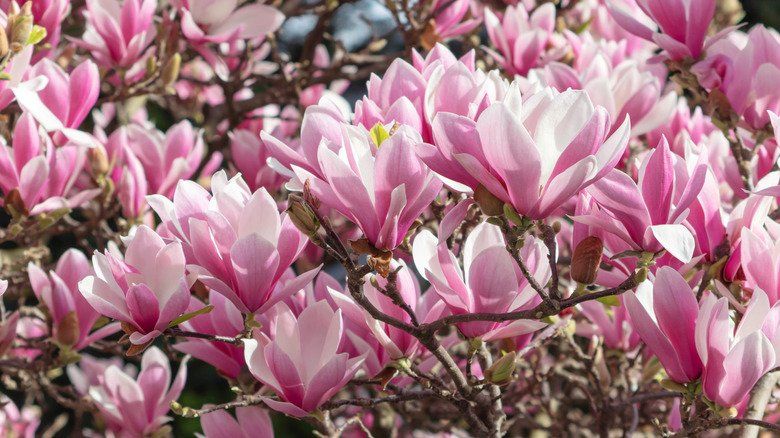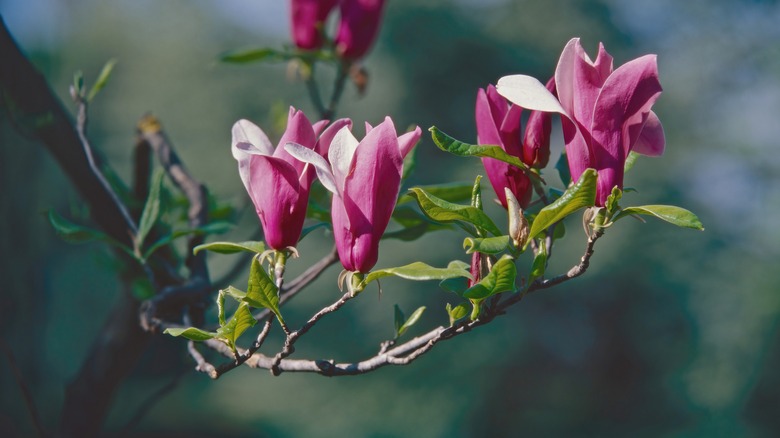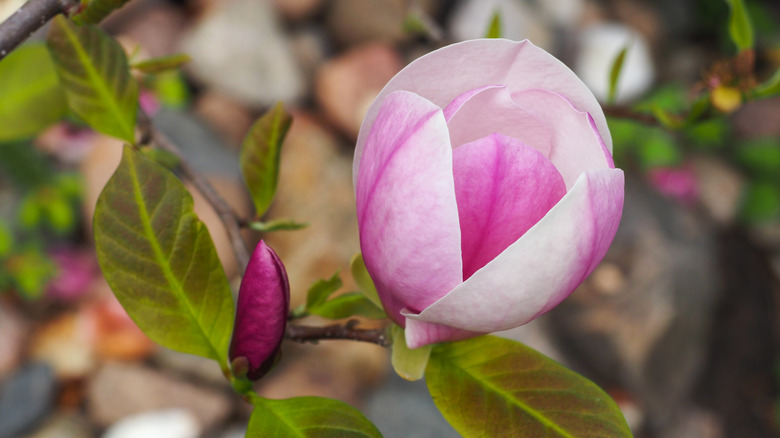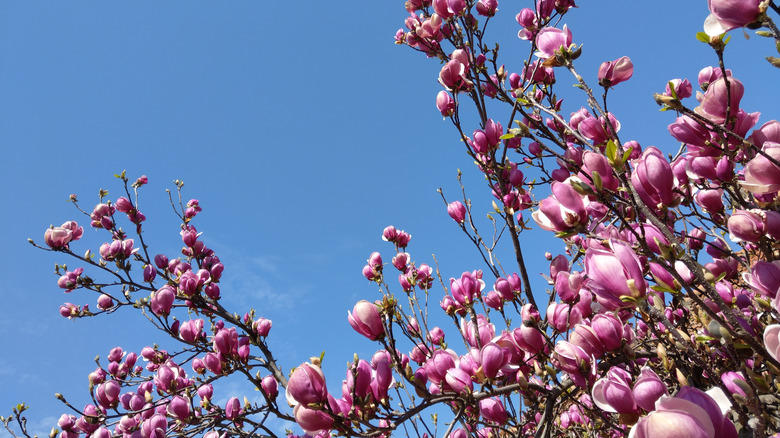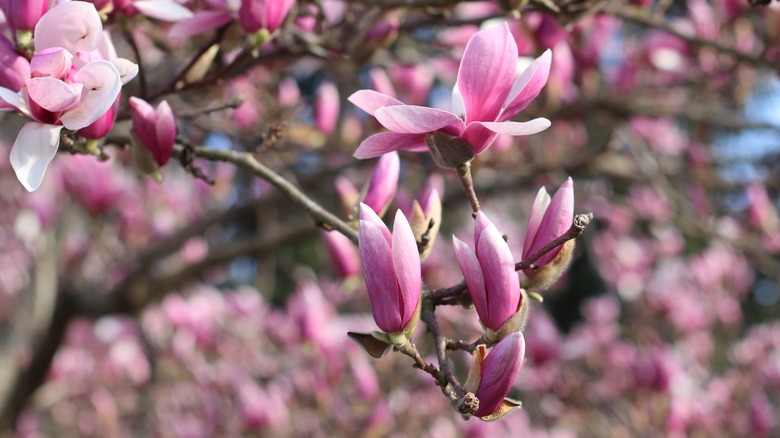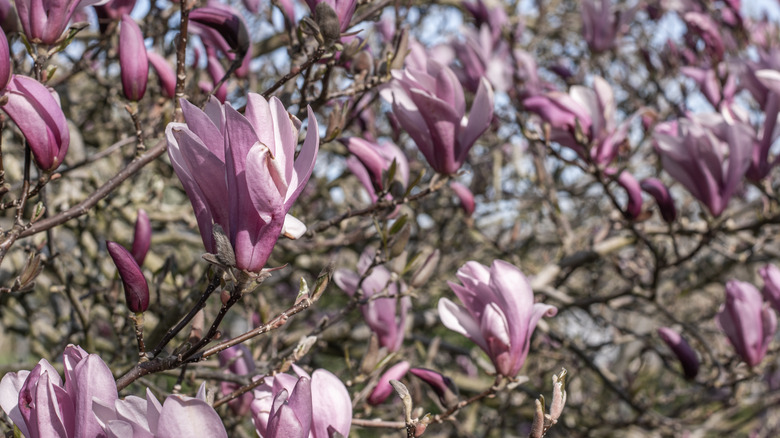How To Care For A Jane Magnolia Tree
Jane magnolia trees are a hybrid variety and member of the Little Girl Series of the flowering trees. Typical magnolia trees bloom in the early spring, which can put them at risk of dying from unexpected frosts and unpredictable weather (via the University of Arkansas Division of Agriculture). The Little Girl Series of magnolias bloom later, getting rid of this threat altogether. The Jane tree specifically is a hybrid of magnolia liliiflora (also known as lily magnolia) 'Reflorescens' and magnolia stellata (also known as star magnolia) 'Waterlily.'
The Little Girl Series of magnolia trees are also more compact than others, only growing up to 15 feet tall. The Spruce states that some people refer to the plant as more of a shrub than a tree due to its size. The flowers of this magnolia hybrid grow a bright but deep pinkish, purplish shade with white interior petals. Mature trees are relatively low maintenance, and the effort they do require is worth it when they bloom the breathtaking petals every spring. Read on to learn how to grow and care for this deciduous pink shrub.
How to use Jane magnolia trees in garden
Jane magnolias are best suited for USDA hardiness zones 4 through 9, according to My Garden Life. For those that can grow the plant in the ground, though, make sure to select an area that gets anywhere from full sun to partial shade. The University of Arkansas Division of Agriculture specifically recommends planting them in a southern or western area of your yard, as northern and eastern exposure can quite significantly slow down blooming.
Be aware when using Jane magnolias in landscaping and yard design projects that it won't grow as tall or canopy-like as other magnolia trees, and will be more bush- or shrub-like in effect. While many like to plant shrubs alongside magnolia trees, perhaps look for lower laying plants, such as ferns, hostas, or different shade loving ground cover, suggests Gardening Know How.
Since the tree bears pink blooms in the spring, consider planting alongside other spring bloomers, such as daffodils or dwarf irises. SFGate also suggests hydrangeas, as they first bloom in the spring, but last until the summer, which will keep your lawn from looking boring later in the season. They also both enjoy acidic soil, making them natural companions.
How to plant a Jane magnolia tree
When it comes to growing a Jane magnolia tree, your best bet will be to look for one at a garden center or tree nursery in the spring or just before. The Spruce recommends planting the tree in the early spring just before the growing season starts, or the late fall as it will be about to enter dormancy. To do this, begin by picking an area with full sun to partial shade, and where it can have plenty of room for roots to grow (away from foundations, buildings, underground pipes, etc.). Be certain in your location pick, as these magnolias don't like to be transplanted.
From there, dig a hole that is as deep as the existing root ball, and roughly three times the width. The soil should be a little acidic, so test your dirt and if it's too alkaline, add a soil acidifier. Also consider adding compost and peat moss to help the soil become richer and looser. Lastly, ensure the soil is well-draining, as they don't like to sit in soggy earth. Fill the hole with dirt and water, and then add 2 inches of mulch on top to help the shrub self-regulate moisture, keeping it 4 inches or so away from the trunk to avoid crown rot.
How to grow a Jane magnolia tree
Once your Jane magnolia tree has reached maturity, you can consider regrowing another one via propagation. The Spruce warns that the shrub is sterile, which means that the flowers do not produce seeds and cannot simply be grown that way. Instead, they have to be regrown by stem cutting propagation.
To do this, look for a branch that is soft to semi-hard and healthy, preferably with a few nodes along the stem. Remove a 4 to 6 inch cutting of the branch with clean and sharp pruning shears — the sharper the shears, the better and faster the plant will heal from the cut. Do this in the morning when the shrub's stems retain more moisture. Wrap the cutting in a wet paper towel. Then, dip the cut end of the stem into a rooting hormone with indole-3-butyric acid (most commonly known as IBA) that is a 4,000 to 5,000 parts per million ratio solution. Fill a 5 inch pot with adequate drainage holes with moist but well draining soil, and plant the cutting. Keep the cutting in a misting chamber if you have one available (cheap DIY kits can be found online), and expect roots to form in eight weeks. To check for root growth, gently tug on the cutting. If it resists, it's time to replant into the spot you'd like to grow it permanently.
How to care for a Jane magnolia tree
Jane magnolia trees are quite self sufficient and low maintenance once mature, but when they are first planted, they need a little work. As stated earlier, they prefer full sun to partial shade, especially when young. Be careful, though, as direct midday sun rays may scorch the leaves. As for soil, just make sure it drains well and retains moisture, advises Planting Tree. Mulching the plant will help with moisture regulation.
Watering is not something to worry about too much with mature plants, as they are drought resistant, and regular rainfall should suffice. In long stretches without rain, you can give them a little drink here and there. When first planted in the spring, though, Jane magnolias should be watered three times a week (be careful not to waterlog the plant). After the plant has established itself, water once or twice a week for a few months until it matures.
When it comes to fertilizing, This Old House recommends feeding once in the beginning of spring as the plant comes out of dormancy with a balanced (meaning all the chemical numbers are the same), slow-release granular fertilizer. You should also add 2 to 3 inches of compost to the top soil of the plant once every fall. The shrub doesn't require pruning, but any pruning of dead or scraggly buds and branches should be done in the spring after it has flowered to avoid killing potential blooms.
Are Jane magnolia trees toxic?
All magnolia trees are generally believed to be non-toxic to humans, cats, and dogs, according to The Nest. That being said, they aren't necessarily edible, and you shouldn't encourage your pets to get into the tree. In fact, eating too much of the tree's flowers or branches can cause mild gastrointestinal upset.
Another major cause for concern are pesticides that you may choose to spray your tree with, which can in fact be fatal when ingested by pets and humans. Surrounding companion plants may also be toxic, so check with each specific member of your outdoor plant collection to make sure it won't lead to a future vet or hospital bill. Keep an eye on curious kids and pets, calling their respective doctor if you think something is wrong.
That being said, there are some suspected benefits of magnolia trees when ingested by humans, with WebMD saying the extract of magnolia bark has been used for more than 1,000 years in the treatment of things like asthma, depression, anxiety, muscle pain, headaches, allergies, digestive issues, ulcers, and may even help prevent serious illnesses like cancer and Alzheimer's disease. Magnolia extract can even be purchased in capsule supplements, though you should always consult with a medical professional before introducing a new supplement to your health care regimen.
